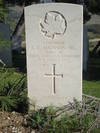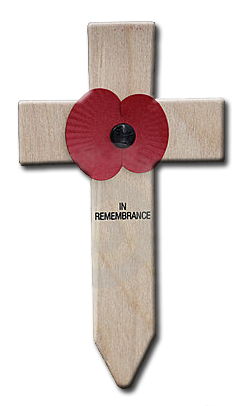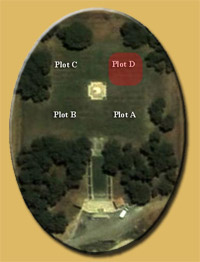










































In Memory of
ATKINSON, GEORGE EATON
Lieutenant
Royal Canadian Engineers
4 Field Coy.
who died 23 age
04th August 1943
AGIRA WAR CEMETERY, SICILY

Lieut. Atkinson's platoon was detailed to make a crossing over the dried river bed to the South West of the town in order that close support weapons could get across to support the attacking infantry.
This officer organized and lead his platoon in a very gallant manner. His personal example of courage was largely responsible for the successful completion of the road, although the work was carried out under continuous mortar and shell fire. As the task was completed, this officer lost his left arm and suffered mutilation of the right arm. In spite of this he continued to command his platoon until all other casualties and the comd, rest of the platoon were evacuated.
Lieutenant George Eaton Atkinson, MC died from his wounds a few days later on 4 August 1943.

George Eaton Atkinson was born in Port Rowan, Ontario, the son of Charles and Linnie Atkinson. He had three older sisters. He was well known in hockey circles, having played on the Simcoe team in the Ontario Hockey League.
George enlisted in Kingston, Ontario on 3 October 1941. He had a degree in engineering from Queen's University and was working as a mining engineer in Timmins, Ontario when he was taken on strength as a Royal Canadian Engineer reinforcement officer with the rank of Second Lieutenant. He was married to Edna Jean (Aroitt) Atkinson at the time. Within a week, he was at the Officer Training Centre in Brockville, Ontario. He completed his basic officer qualification and was sent to A5 Canadian Engineer Training Centre (CETC) in Camp Petawawa for Engineer Officer training which he completed on 13 March 1942 with a promotion to Lieutenant.
George stayed on strength of A5 CETC until mid-August when he was shipped overseas, landing in Liverpool, England. He was taken on strength of 1 Canadian Engineer Reinforcement Unit (1 CERU) located at Guillemont Barracks in Hampshire in southern England. The CERU was organized into holding companies whose main task was completing individual training started in Canada before new arrivals were sent out to units. More experienced and qualified officers and non-commissioned officers were often kept on as instructors. Already qualified as a Class III Driver, George also qualified as a motorcycle driver at the CERU as well and rounding off his engineer officer skills.
 From the time George joined the 4th Field Company in April 1943, training focused on preparing to invade Europe. They did not know where or when, but they knew they would be among the first and would be landing by sea. The training was rigorous and covered combined operations, mountain warfare, bridging, mine and booby trap clearance, small arms, route repair and construction, field craft and small arms practice. There was even some rudimentary German language training.
From the time George joined the 4th Field Company in April 1943, training focused on preparing to invade Europe. They did not know where or when, but they knew they would be among the first and would be landing by sea. The training was rigorous and covered combined operations, mountain warfare, bridging, mine and booby trap clearance, small arms, route repair and construction, field craft and small arms practice. There was even some rudimentary German language training.
In June 1943, the Company was in Scotland and had just completed three weeks of mountain warfare when they took part in an amphibious landing exercise on the west coast of Scotland. They were issued tropical clothing and trained to waterproof their own vehicles. By this time, the whole division was on edge with tensions rising and rumours spreading about where and when they would see action. Would it be Greece? Crete? Sicily? No sooner was the exercise completed than they were issued tropical clothing and loaded onto ships for a week-long amphibious landing exercise and carried out an assault landing from landing craft. On 30 June, all troops were embarked wearing tropical clothing when they were told the 1st Canadian Division was now part of Montgomery's 8th Army and were headed to Sicily.
Ten days later, on 10 July 1943 and after a concentrated naval and air attack along the landing beaches, the 1st Canadian Division landed at Pachino along the southeast coast. The 1st and 3rd Field Companies landed in the assault with the 1st and 2nd Canadian Infantry Brigades. The 4th Field Company followed up with the 3rd Brigade later that afternoon.
By late July 1943, the Allied forces in Sicily were tired and General Montgomery called a halt for all but the 1st Canadian Division. They were assigned the task to open the way to the strategically located town of Adrano. However, before Adrano stood the well-fortified hill town of Agira. With Mount Etna overlooking their advance, the division pushed hard and after five days of heavy fighting by the 1st and 2nd Infantry Brigades, Agira fell. It was the biggest battle to date for the Canadians and cost 438 casualties.
Meanwhile, on their right, the 3rd Infantry Brigade with the 4th Field Squadron under command moved directly towards Adrano with the intermediate objective of Catenanuova. The challenge here was to establish a bridgehead across the Dittaino River, near the town, so that follow on British 78th Division could take up the advance to Adrano.
The attack on the town was launched before midnight on 29 July under a heavy barrage. A part platoon of the 4th Field Company had been detached to each of the Royal 22e Regiment and the West Nova Scotia Regiment. The initial assault was quite successful and the West Nova Scotia Regiment forced the defending 923rd Fortress Battalion to run away. However, there was still determined opposition from commanding positions and particularly from a high spur to the southwest. The Royal 22e Regiment attacked the high ground and by late morning, the heights were under Canadian control. However, small elements of the vanquished Fortress Battalion were still holding excellent observation posts north of the town and stopped the further advance of the West Nova Scotia Regiment, but more importantly, prevented any support from being pushed forward.
The riverbed was swept by fire all day. Bulldozers (a D-4 and a D-6) had gone forward at 0130 hours together with other parties of the 4th Field Company. The construction of crossings was attempted in two places but mortar and shell fire stopped the proceedings. Efforts were concentrated on one of these sites at first light and the job was about 25 per cent complete when the sappers were pinned to the ground - machine gun and rifle fire being added to the rest. Lieutenant R. O. Riley was wounded and, because of the fire, he could not be evacuated for some time. A new site for the crossing was chosen at about noon. Lieutenant G. E. Atkinson and his platoon cut down the steep banks and graded the rough bed. By 1900 hours a route was available to get close-support weapons over to the now hard-pressed infantry. All afternoon the platoon had worked under mortar and machine-gun fire. In the end, Atkinson had had his left arm blown off below the elbow and his right mutilated, but he continued to lead and encourage his men until the task was complete and the other casualties evacuated.
"For the ultimate arrival of this much-needed aid the West Novas had to thank a platoon of the 4th Field Company R.C.E., who throughout the day toiled heroically under mortar and shrapnel fire to level a track across the rough bed and grade the deeply cut banks of the Dittaino. Under these harassing conditions the sappers were inspired to their best efforts by the gallant leadership of the platoon commander, Lieutenant G.E. Atkinson, who even when both arms had been mutilated by shrapnel continued to direct the operations of his men until their task was completed and all other casualties had been evacuated. The Military Cross awarded to Atkinson was one of eleven decorations given in recognition of the plucky work in Sicily of the officers and men of the Royal Canadian Engineers." (1)
The 4th Field Company had now lost four officers, killed or wounded in just 12 days. Seven other ranks were wounded in this one operation. Lieutenant George Eaton Atkinson, MC died from his wounds a few days later on 4 August 1943. He is buried along side his comrades in the Agira Canadian War Cemetery.
Note: Atkinson Lake, Northwest Territories was named after George Atkinson.
Return to Main Gallantry Article
Return to Main Tributes Article
CitationOn 30 July 1943, 3 Canadian Infantry Brigade was attacking Catenenuava. Lieutenant Atkinson's platoon was detailed to make a crossing over the dried river bed to the southwest of the town in order that close support weapons could get across to support the attacking infantry.
This officer organized and led his platoon in a very gallant manner. His personal example of courage was largely responsible for the successful completion of the road, although the work was carried out under continuous mortar and shell fire. As the task was completed, this officer lost his left arm and suffered mutilation of the right arm. In spite of this, he continued to command his platoon until all other casualties and the rest of the platoon were evacuated.












